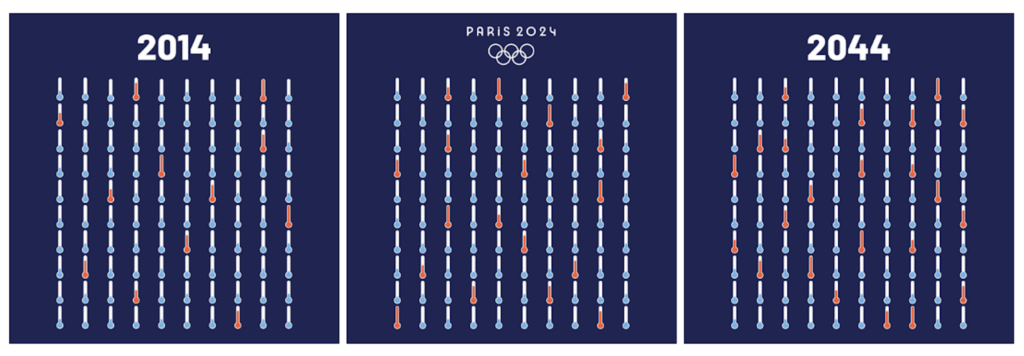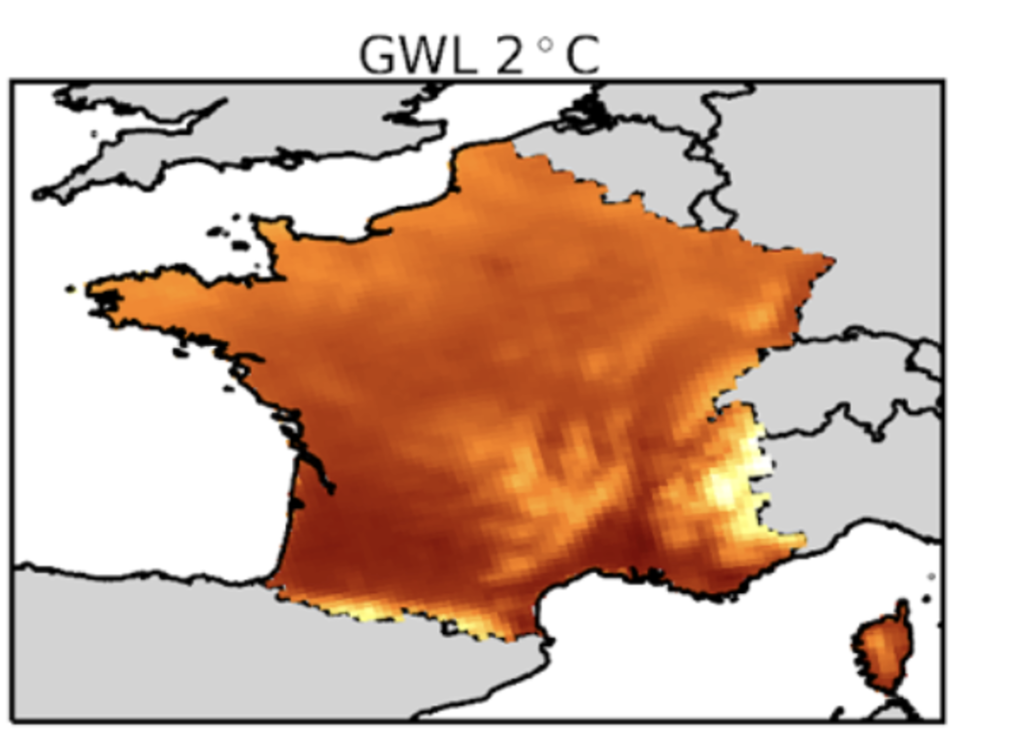Beating the heat: I4C sheds light on the Paris 2024 Olympics
At 7:00 on 8 August 2021, marathon competitors for the Tokyo Olympics gathered at the starting line. Only they weren’t in Tokyo, but 800 kilometres to the north, in Sapporo. This relocation was a strategic decision to avoid Tokyo’s mid-summer heat and humidity. In the end, the move didn’t make much of a difference: the temperature in Sapporo on race day was 26°C. Fast forward to 2024 and Paris. The conversation is again about the likelihood and risks posed by extreme high temperatures for athletes, spectators and local residents.
The Olympics are here! From 26 July to 11 August 2024, top athletes from around the world will be in Paris, competing in a host of outdoor and indoor sports. Many of these, such as the marathon and tennis, can be adversely affected by high temperatures.
What are the potential risks posed by heat extremes for the Olympic Games in Paris, but also other European cities over the longer term? Read on for insights gleaned from high-resolution climate models analysed by our teams of experts.
Paris state of play
Paris is known for its heat island effect, which can make temperatures ~2.5°C warmer compared to the surrounding countryside, with hotspots up to 8°C warmer. This phenomenon, combined with climate change and the city’s exposure to extreme heat, raises significant concerns far beyond athlete health and well-being to that of the Olympic workers, spectators and residents of the Paris metropolitan area.
Over the past two decades, Paris has been hit by several heatwaves, most notably in 2003 and 2022 when observed temperatures reached 39.5°C and 40.5°C, respectively. Recent studies suggest that the intensity of the 2003 heatwave, which set alarming records, could be exceeded by up to 4°C before 2050 (Yiou et al., 2023). Equally worrying is the expected increase in the duration of heatwaves. In addition to rising maximum temperatures, longer heatwave periods are expected as global temperatures continue to rise.
I4C heatwave metrics: Understanding and preparing for extreme heat in cities
While the science is clear that rising global temperatures will mean urban areas are increasingly exposed to heat extremes, the details are only starting to come into focus. I4C has performed analyses of a large number of high-resolution models that provide information at the city-scale, and the findings are striking.
Zooming in on the data
The figure below presents a year-to-year time series from many high-resolution model simulations of the maximum annual heatwave temperature over Paris. For reference, the HW annual index is the maximum daily temperature that occurs during any heatwave in that year. A heatwave is defined as three or more days in succession above a predefined local threshold. The 2003 and 2022 events are shown in the dashed line for reference and are taken from the ERA5 reanalysis. Each grey line represents a possible climate trajectory, and the black line is their long-term mean.

Image credit: Stephen Outten (NERSC)
Based on I4C’s analysis, it is possible to look at a period around a given year and consider whether heatwave maximum temperatures may exceed the 2022 level. This data pooling results in 335 simulated events and aids statistical calculations. As represented in the figure below, the likelihood of extreme summer heat has significantly increased over time. For example, in summer 2014, when the Paris Olympics were planned, the likelihood was 12%. By 2024, it rises to around 18%, and by 2044, it could exceed 23%. Below is a graphical representation of these statistics:

The projected heatwave temperatures in 10-20 years from now will be so severe that coping with the associated risks for such a huge international event could be an imprudent gamble even considering the rate of deployment of current and planned adaptation strategies. This conclusion is valid whatever the emission pathway, which has a small impact on future warming levels at near-term. This means that adaptation will become an important part of planning future Olympics. Looking further ahead, by 2075, in the high-end scenario presented here, the extreme heat of summers like those of 2003 or 2022 will become the new normal.
Empowering cities with I4C’s heatwave metrics
When considering the usefulness of any analysis of future extremes, it is important to recognise that there will be numerous new climate datasets and many different metrics, each with unique strengths and limitations. The metrics presented in this article were developed by I4C, in collaboration with urban planners and climate experts, to provide a practical and relevant measure for decision-making in urban contexts.

The right-hand map shows projected heatwave magnitude at specific levels of future warming. This is another way of thinking about heatwave risk in the context of global warming levels (GWL). GWLs are reference policy targets used in international climate change mitigation discussions, such as the Paris Agreement, and designing national or local adaptation plans. At the +2°C GWL a projected mean maximum heatwave temperature is likely to be 34°C with a high probability for even hotter temperatures over the Paris metropolitan area.
Image credit: Stephen Outten (NERSC)

Carrying the climate resilience torch beyond 2024
Few events capture the public imagination like the Olympic Games. Yet, these epic events also highlight major societal challenges, particularly those posed by climate change. Summer 2022 would have been exceptional in the 80s but now has a greater than 1 in 6 chance of occurring under the current Paris’ climate. Realistically speaking, 2024 is probably the last chance to safely host the Summer Olympics in Paris, or any city similarly exposed to extreme heat without robust heat-oriented adaptation measures. However, with strong climate action and intentional transformation, cities can mitigate these risks for their residents and become climate-smart and resilient.
Looking ahead, I4C will continue to work closely with municipal partners and stakeholders to better understand the risks posed by heat extremes in Paris and other European urban areas. We will incorporate more accurate urban features into modelling systems and develop innovative methods to increase our confidence in future climate predictions.
Learn more about I4C’s near-term hazard assessment by subscribing to the project’s newsletter. Stay updated about the latest project findings and activities!
